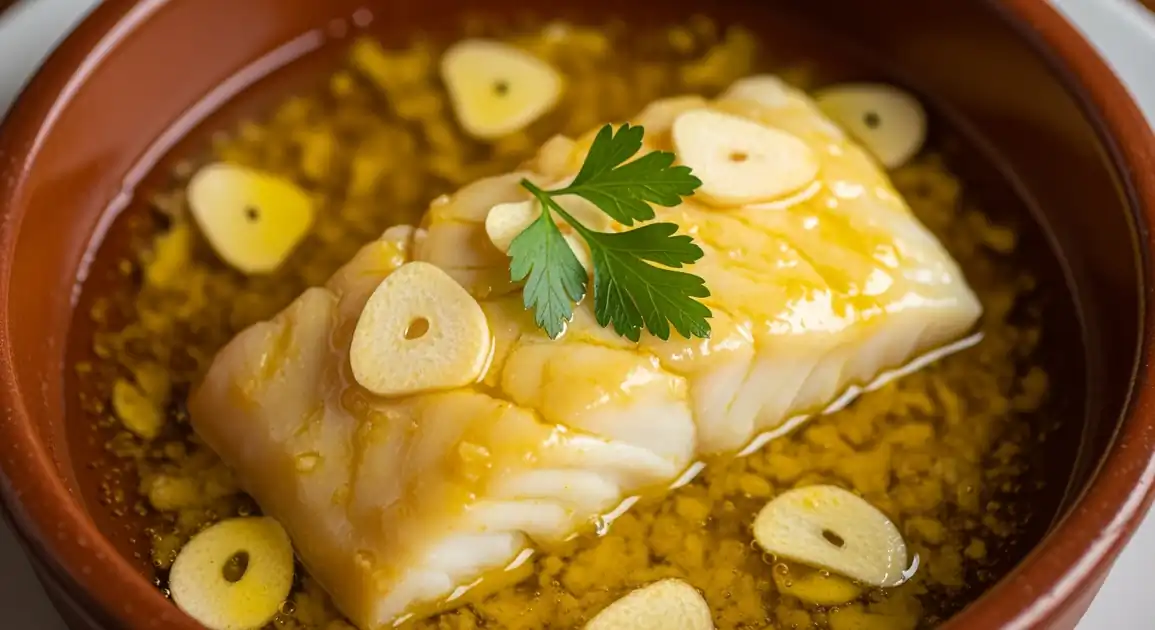Bacalao (Salted Cod)
Bacalao

Description
Seville offers a distinctive Andalusian approach to bacalao, characterized by lighter, olive oil-rich preparations and frequent use of local ingredients like bitter oranges, almonds, and regional spices. Though inland, Seville's historical importance as a trading hub connected to the Atlantic ensured bacalao became embedded in local cuisine. The city celebrates this preserved fish particularly during Semana Santa (Holy Week), when bacalao dishes are traditionally consumed in observance of Catholic meat restrictions.
Dietary Information
Serving information
Serving style
Predominantly served as tapas ('tapas' or 'media raciones') in bars, as main courses in restaurants, and in traditional clay cazuelas for certain preparations like 'bacalao con tomate'. Often accompanied by Andalusian garnishes like crispy fried garlic chips or parsley.
Quick facts
Tapas Bars: Often continuous service from midday with peak times 1:30-4 PM and 8:30-11:30 PM. Restaurants: Lunch 2 PM - 4:30 PM, Dinner 9 PM - midnight. Markets: Typically 8 AM - 3 PM (some food stalls may have extended hours).
Safety Tips
What to Look For
-
Properly cooked fish: Opaque white flesh that flakes easily with a fork.
Ensures the cod is cooked through, reducing risks associated with undercooked fish.
-
Reputable establishment known for Bacalao
Restaurants or bars specializing in or famed for their cod dishes are more likely to handle and prepare it correctly (especially desalting).
-
Appears freshly prepared (especially fried items)
Fried bacalao should ideally be cooked to order or very recently fried to be crispy and hot, minimizing time in the temperature danger zone.
-
Balanced flavor (not overly salty)
Excessive saltiness indicates improper or insufficient desalting, which affects taste and potentially health.
-
Properly emulsified sauce (e.g., Pil Pil)
A well-made, stable emulsion suggests care in preparation, though not directly a safety issue, it indicates quality.
What to avoid
-
Overpowering salty taste
Suggests the cod was not desalted correctly. While not acutely dangerous for most, it's a quality failure and unpleasant.
-
Dry, tough, or stringy texture
Can indicate poor quality cod, improper storage/handling, or overcooking.
-
Any 'off' or excessively fishy smell
Salted cod should smell clean and mildly of the sea; strong unpleasant odors indicate potential spoilage.
-
Dishes sitting at lukewarm temperatures
Allows for bacterial growth. Ensure the dish is served properly hot (if cooked) or cold (if a cold preparation like Esqueixada).
-
Establishments with poor general hygiene
General cleanliness reflects overall food handling practices.
Price information
Price range
Budget tips
- Sample bacalao tapas in traditional bars for 3-5 EUR per portion.
- Market bars offer excellent value bacalao dishes for 7-12 EUR.
- Mid-range restaurants serve main course bacalao preparations for 14-20 EUR.
- Higher-end establishments present refined Andalusian bacalao interpretations for 20-28 EUR.
- Look for 'menú del día' options which might include seasonal bacalao dishes at value prices (10-15 EUR).
Value indicators
- Generosity with quality olive oil (essential in Sevillian cuisine).
- Proper desalting with balanced salt level.
- Freshness of accompanying ingredients, particularly vegetables.
- Portion size relative to price, especially for tapas.
- Care in preparation evident in texture and presentation.
Where to Find This Dish
Santa Cruz
Historic Jewish quarter with traditional tabernas and tapas bars serving Sevillian bacalao specialties.
Plaza de Santa Cruz, Calle Mateos Gago, Callejón del Agua
Lunch, Evening Tapas
Triana
Former fishermen's and ceramic artisans' quarter across the river with authentic family-run establishments serving traditional bacalao recipes.
Mercado de Triana, Calle Betis, Calle Pureza
Lunch, Evening
Alameda de Hércules
Bohemian area with a mix of traditional bacalao-serving taverns and modern venues offering creative interpretations.
Alameda de Hércules plaza
Evening, Night
Market Areas
Historic markets feature both raw bacalao vendors and tapas bars or food stalls serving prepared dishes.
Mercado de Triana, Mercado de la Encarnación (Setas), Mercado de Feria
Morning to Early Afternoon (market hours)
Vendor Tips
- During Semana Santa, seek out establishments advertising special bacalao menus—this is when Seville's bacalao tradition is at its peak.
- Look for bars with a 'Especial Bacalao' board or listing of several bacalao preparations—these often specialize in quality cod dishes.
- In Triana, family-run establishments often serve traditional bacalao recipes passed through generations.
- Watch for recommended places serving 'Soldaditos de Pavía' (Sevillian-style fried cod), a local specialty.
How to Order
Regional Variations
-
Soldiers of Pavía
(Soldaditos de Pavía)
A Sevillian specialty: strips of battered, deep-fried cod, often served with strips of roasted red pepper. Named after the red and yellow colors reminiscent of Spanish military uniforms.
-
Cod with Tomato
(Bacalao con tomate)
Sevillian preparation featuring cod cooked in a rich tomato sauce with onions, garlic, and olive oil. Often served in a clay cazuela with a sprinkle of parsley.
-
Orange-Infused Cod
(Bacalao a la naranja)
Distinctly Sevillian preparation incorporating the city's famous bitter oranges, creating a sweet-sour flavor profile unique to the region.
-
Almond Cod
(Bacalao a la sevillana)
Traditional preparation featuring ground almonds, garlic, and sometimes saffron in the sauce, reflecting Andalusia's Moorish culinary influences.
Cultural context
History
The tradition of consuming salted cod in Spain dates back centuries, linked to Basque whaling and fishing expeditions in the North Atlantic. Salting was an effective preservation method allowing cod to be transported far inland and consumed year-round. It became deeply integrated into the cuisine, especially vital during Catholic Lent ('Cuaresma' or 'Semana Santa') when meat was restricted, leading to famous dishes like 'Potaje de Vigilia'.
Local significance
In Seville, bacalao transcends mere culinary significance to become a cultural and religious symbol, particularly during Holy Week. The tradition of consuming bacalao during periods of religious meat abstinence has transformed this preserved fish into an essential element of Sevillian identity and seasonal celebration.
Eating customs
- Typically accompanied by local sherry wines, particularly fino or manzanilla.
- Often enjoyed standing at the bar in traditional establishments, especially when having tapas.
- Served with excellent local olive oil, which features prominently in Sevillian bacalao preparations.
- Rarely eaten alone—sharing multiple dishes is fundamental to Sevillian dining culture.